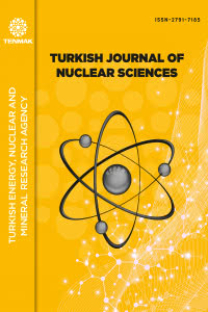Gamma Ray Peak Area Ratio for Determination of 15-30 MeV Proton Beam Energy (15-30 MeV Proton Demeti Enerjisinin Belirlenmesi İçin Gama Pik Alanı Oranı Kullanılması)
Gamma Ray Peak Area Ratio for Determination of 15-30 MeV Proton Beam Energy (15-30 MeV Proton Demeti Enerjisinin Belirlenmesi İçin Gama Pik Alanı Oranı Kullanılması)
TENMAK Proton Hızlandırıcısı Tesisinde bulunan siklotron tipi dairesel hızlandırıcıdan elde edilen proton demetinin enerjisi, stripper ekstraksiyon sistemi kullanılarak 15-30 MeV aralığında ayarlanabilmektedir. Ekstarksiyon sisteminin bir parçası olan karbon folyo siklotron merkezine doğru yaklaştıkça dairesel hareketin yarıçapı azalacağından daha düşük enerjili proton demeti elde edilir. Bu çalışmada, hızlandırıcı kontrol sistemi tarafından ölçülen proton demet enerjisi, durdurma gücü prensibine uygun olarak 2 mm kalınlığında alüminyum yavaşlatıcı, floresan ekran ve SRIM (versiyon 2013.00) bilgisayar programı kullanılarak doğrulanmıştır. Daha sonra, 25 µm kalınlığında 5 saf bakır folyo ve her biri 1 mm kalınlığında 4 alüminyum yavaşlatıcı kullanılarak proton ışınının enerjisini belirlemek için bakır folyoların aktivasyon değerlerine dayalı bir oran tablosu hazırlanmıştır. Hızlandırıcı kontrol sistemindeki değişiklikler, hatalar ve arızalar durumunda ve pahalı enerji dedektörlerinin yokluğunda, proton ışını enerjisi bu çalışmada açıklanan yöntemle pratik olarak ve belirli bir hassasiyetle belirlenebilir. (The energy of the proton beam produced by the cyclotron at TENMAK-PAF can be adjusted between 15 – 30 MeV by extraction systems. As the carbon stripper foil, which is part of the extraction system become closer to the center of the cyclotron, the turning radius of the beam decreases, therefore lower energy proton beam can be obtained. In this study, the proton beam energy measured by the accelerator control system was verified by using a 2 mm thick aluminium degrader, a fluorescence screen and SRIM (version 2013.00) computer program in accordance with the stopping power principle. Then a ratio table, based on the activation values of the copper foils was prepared to determine the energy of the proton beam using 5 pure copper foils of 25 µm thickness and 4 aluminium degraders of 1 mm thickness each. In the event of changes, faults and malfunctions in the accelerator control system and in the absence of expensive energy detectors, the proton beam energy can be determined practically and with a certain sensitivity by the method described in this study.)
Keywords:
Cyclotron, Proton beam energy, stack foil, gamma ray. activation,
___
- 1. Kim K. R, Cho Y. S., Hong I. S.,Park B. S., Yun S. P., Kim H. S., Kim K. R., Cho Y. S., Hong I. S., Park B. S., Yun S. P.,Kim H. S., Proceedings of PAC07, Albuquerque, New Mexico, USA, 2007, IEEE.
- 2. Schneider U., Renker D., Nucl. Instr. & Methods A 388, (1997), p. 199-203.
- 3. Ha J. H., Kim J. C., Kim Y. K., Youn M., Chae S. J., Chung H. T., Choi J. H., Lee C. S., Kwon J. U., Moon C. B., Chai J. S., Kim Y.S., Lee J. D. , Nucl. Instr. & Methods A 388, (1994), p. 199-203.
- 4. Ziegler J. F., Biersack J. P., SRIM-2000, 40: The Stopping and Range of Ions in Matter (IBM-Research, town, New York, 2000), p. 40.
- 5. Kim J. H., Park H., Kim S., Lee J. S. and Chun K. S., Journal of the Korean Physical Society, 48, (2006), p 755-758.
- 6. Burrage J. W., Asad A. H., Fox R. A., Price RI, Campbell AM, Siddiqui S., Australas Phys Eng Sci Med, 32(2) (2009), p. 92-97.
- 7. Khandaker M. U., Kim G., Kim K., Kassim H. B. E, and Nikouravan B, International Journal of the Physical Sciences Vol. 6(13), (2011), p. 3168-3174.
- 8. Avila-Rodriguez M. A., Rajander,J., Lill, J.-O., Gagnon K., Schlesinger J., Wilson J. S., McQuarrie S. A.; Solin O., Nuclear Instruments and Methods in Physics Research Section B 267, (2009), p. 1867-1872.
- 9. Gogan K., Jensen M., Thisgaard H., Publicover J., Lapi S., McQuarrie S. A., Ruth T. J, Applied Radiation and Isotopes 69, (2011), p. 247-253.
- 10. Charged Particle Cross-Section Database for Medical Radioisotope Production: Diagnostic Radioisotopes andMonitor Reactions, IAEA- TECDOC-1211 (2001), p. 1.
- Başlangıç: 1981
- Yayıncı: -
